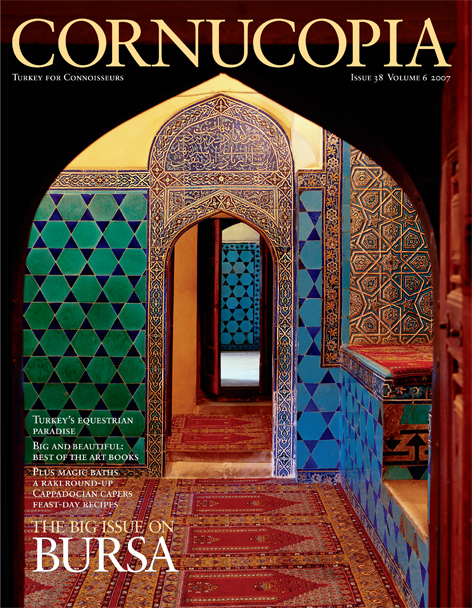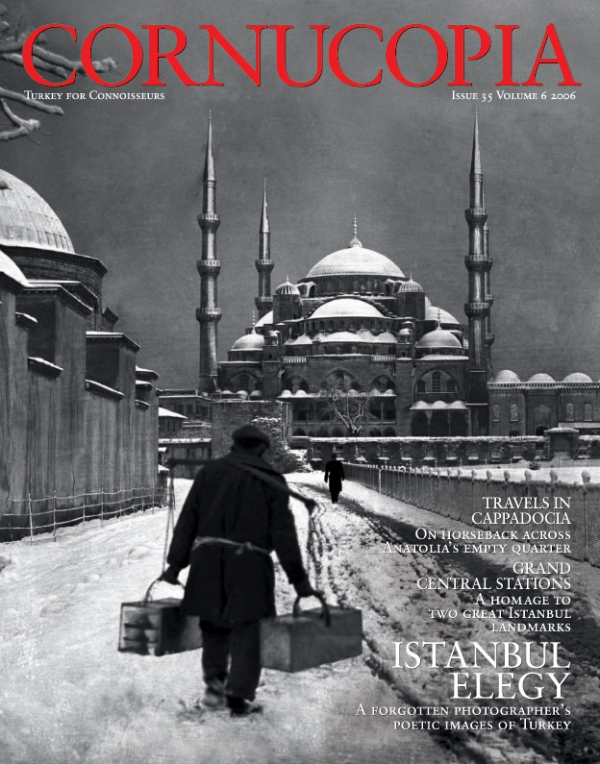Buy or gift a stand-alone digital subscription and get unlimited access to dozens of back issues for just £18.99 / $18.99 a year.
Please register at www.exacteditions.com/digital/cornucopia with your subscriber account number or contact subscriptions@cornucopia.net
Buy a digital subscription Go to the Digital EditionFor 700 years, the European quarter was home to Genoese, Jews, Greeks and many others. Norman Stone charts the district’s changing fortunes
The 14th-century Galata Tower is one of Istanbul’s most obvious landmarks, and it symbolises the strong European influence in the city. The quarter around it, on the northern side of the Golden Horn, had been a Genoese colony, but it expanded to take in many of the Jews and most of the Christians. The foreign embassies were there, along with churches and schools, and as 19th-century reforms went ahead, Galata acquired banks, hotels, insurance offices of a type that you can see anywhere between Glasgow’s St Vincent Street and Budapest.
In the 1880s Galata and its neighbour up the hill, Pera, were huge building sites, with Art Nouveau all around, together with smart cafés and fashionable French shops where you heard innumerable languages. Some of the buildings are very good indeed. The best address in Istanbul is probably the Doğan Apartments, just down a hill from the Swedish embassy, up a hill from the Anglican church, and opposite the Deutsche Schule (1868). Itstands on land given up by the Prussian Legation and is a tall, Italian-designed, U-shaped building, looking out over the Bosphorus. The street in which it stands, Serdar-ı Ekrem, has another comparable building, once the palace of a Jewish banking family, the Camondos, which has been converted into a grand short-stay apartment-hotel. Much of Galata now looks as it used to. But it was not ever thus. Twenty years ago the place was a ruin: from the roof of the Camondo Palace, shrubs and trees were growing, and Pera was only really saved because the old foreign embassies, with their gardens, were inviolate.
The decline dated from September 6, 1955, the stupidest day in the history of the Turkish Republic. Around 5pm crowds of enraged nationalists gathered at Taksim and moved down the main street, smashing shop windows, looting goods and roughing up innocents. Their target was the Greek minority of Istanbul and the pretext was retaliation for Greek Cypriot atrocities, which were real enough.
But sinister forces were behind the Galata pogrom. The 150,000 Greeks of Istanbul had property (they accounted for half the stock exchange) and they fled over the next few years. They had been Turkey’s most obvious agents in dealing with Western Europe, and they were almost entirely loyal, with parliamentary deputies in the government party. When, to punish the malefactors, a subsequent military regime put that party’s leaders on trial, the Orthodox Patriarch spoke in their defence. These Istanbul Greeks, with a presence going back thousands of years, had nothing in common with their pain-in-the-neck Cypriot cousins. And Istanbul paid a terrible price.
The Greek buildings were abandoned, to rot for the next 40 years. They were taken over by squatters, and the quarter became notoriously dangerous. It began to recover only in 1990, when a formidable lady, Ceylan Orhun, a trained architect, spotted the potential of a splendid Italian-built block on the Tower square, and established a bridgehead. On a side wall below the building there was a sign that said it all: “Buraya çöp atan orosbu çocuğur” (sic) (“Anyone who dumps rubbish here is a son of a whore”), with “eşektir” (“…is a donkey”) crossed out. As in Hogarthian London, people just chucked the rubbish out of the window. But now the squatters are gone, and the reconstruction is spectacular.
Galata was always a place where foreign elements settled, on the other side (the meaning of Pera) of the Golden Horn. The name Galata is very old, and its origins are not clear, though common sense suggests that it has something to do with Galatia, where, in the centre of Anatolia, Celtic mercenary tribes set up a kingdom, the subjects of which were addressed by St Paul.
Norman Stone is the author of ‘Turkey: A Short History’ (Thames & Hudson) £9.95
 Issue 51, Summer 2014
Istanbul Unwrapped: The European City and the Sultan’s New City
Issue 51, Summer 2014
Istanbul Unwrapped: The European City and the Sultan’s New City
As the old European quarters flourished in their seclusion, Sultan Abdülmecid had a dream – and expanded to the east
The Sakip Sabanci Museum has just celebrated 600 years of diplomatic relations between Poland and Turkey. Jason Goodwin finds deep-rooted affinities between the two countries
John Carswell introduces the mesmerising entries in this year’s Ancient and Modern Prize for original research
With 19th-century Istanbul in thrall to the music of Italy, an extraordinary theatre was born, the creation of one rather ‘odd character’. Emre Aracı tells a tale of comedy and tragedy
Black musicians, White Russian princesses, Turkish flappers… During the Jazz Age, Beyoğlu was a ferment of modernity and decadence. By Thomas Roueché
Maureen Freely recalls the artists and writers who enlivened her childhood with their flamboyant bravado and unspoken sadness
In the very thick of the city, with its fret and fuss, belching traffic and urban sprawl, lies a glade scented with linden blossoms. Here the young Sultan Abdülmecid built a jewel of a palace, grand but tiny, which is still a green oasis and place of escape. By Berrin Torolsan
Until the 20th century, visitors would sail serenely into Istanbul to disembark opposite the Topkapi. After this spectacular start, reality would set in. By David Barchard
For more than two centuries the Ottomans were obsessed by the elegance of the tulip and grew over 3,000 varieties, each characterised by almond-shaped petals drawn out into an exaggerated taper.
With its hundreds of different shapes, pasta is today one of the most widely consumed and enjoyed of all the staples
Across the Golden Horn from the Topkapı and the bazaars is the European City, where fortunes have for centuries been made and lost.
Patricia Daunt extols the palatial embassiess that adorn the heights of old Pera. Photographs by Brian McKee



 Issue 51, Summer 2014
Istanbul Unwrapped: The European City and the Sultan’s New City
Issue 51, Summer 2014
Istanbul Unwrapped: The European City and the Sultan’s New City











Cornucopia works in partnership with the digital publishing platform Exact Editions to offer individual and institutional subscribers unlimited access to a searchable archive of fascinating back issues and every newly published issue. The digital edition of Cornucopia is available cross-platform on web, iOS and Android and offers a comprehensive search function, allowing the title’s cultural content to be delved into at the touch of a button.
Digital Subscription: £18.99 / $18.99 (1 year)
Subscribe now